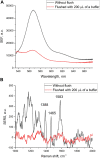Aptamer-coated track-etched membranes with a nanostructured silver layer for single virus detection in biological fluids
- PMID: 36704305
- PMCID: PMC9871243
- DOI: 10.3389/fbioe.2022.1076749
Aptamer-coated track-etched membranes with a nanostructured silver layer for single virus detection in biological fluids
Abstract
Aptasensors based on surface-enhanced Raman spectroscopy (SERS) are of high interest due to the superior specificity and low limit of detection. It is possible to produce stable and cheap SERS-active substrates and portable equipment meeting the requirements of point-of-care devices. Here we combine the membrane filtration and SERS-active substrate in the one pot. This approach allows efficient adsorption of the viruses from the solution onto aptamer-covered silver nanoparticles. Specific determination of the viruses was provided by the aptamer to influenza A virus labeled with the Raman-active label. The SERS-signal from the label was decreased with a descending concentration of the target virus. Even several virus particles in the sample provided an increase in SERS-spectra intensity, requiring only a few minutes for the interaction between the aptamer and the virus. The limit of detection of the aptasensor was as low as 10 viral particles per mL (VP/mL) of influenza A virus or 2 VP/mL per probe. This value overcomes the limit of detection of PCR techniques (∼103 VP/mL). The proposed biosensor is very convenient for point-of-care applications.
Keywords: SERS; aptamer; aptasensor; influenza; membrane; virus.
Copyright © 2023 Kukushkin, Kristavchuk, Andreev, Meshcheryakova, Zaborova, Gambaryan, Nechaev and Zavyalova.
Conflict of interest statement
The authors declare that the research was conducted in the absence of any commercial or financial relationships that could be construed as a potential conflict of interest.
Figures








Similar articles
-
Nanoisland SERS-Substrates for Specific Detection and Quantification of Influenza A Virus.Biosensors (Basel). 2023 Dec 29;14(1):20. doi: 10.3390/bios14010020. Biosensors (Basel). 2023. PMID: 38248397 Free PMC article.
-
A Combination of Membrane Filtration and Raman-Active DNA Ligand Greatly Enhances Sensitivity of SERS-Based Aptasensors for Influenza A Virus.Front Chem. 2022 Jun 30;10:937180. doi: 10.3389/fchem.2022.937180. eCollection 2022. Front Chem. 2022. PMID: 35844641 Free PMC article.
-
SERS imaging-based aptasensor for ultrasensitive and reproducible detection of influenza virus A.Biosens Bioelectron. 2020 Nov 1;167:112496. doi: 10.1016/j.bios.2020.112496. Epub 2020 Aug 4. Biosens Bioelectron. 2020. PMID: 32818752
-
Advances in Surface-Enhanced Raman Scattering-Based Aptasensors for Food Safety Detection.J Agric Food Chem. 2021 Dec 1;69(47):14049-14064. doi: 10.1021/acs.jafc.1c05274. Epub 2021 Nov 19. J Agric Food Chem. 2021. PMID: 34798776 Review.
-
Aptamer-based biosensors for virus protein detection.Trends Analyt Chem. 2022 Dec;157:116738. doi: 10.1016/j.trac.2022.116738. Epub 2022 Jul 19. Trends Analyt Chem. 2022. PMID: 35874498 Free PMC article. Review.
Cited by
-
Aptamers Targeting Membrane Proteins for Sensor and Diagnostic Applications.Molecules. 2023 Apr 26;28(9):3728. doi: 10.3390/molecules28093728. Molecules. 2023. PMID: 37175137 Free PMC article. Review.
-
Advances in flexible graphene field-effect transistors for biomolecule sensing.Front Bioeng Biotechnol. 2023 Jul 7;11:1218024. doi: 10.3389/fbioe.2023.1218024. eCollection 2023. Front Bioeng Biotechnol. 2023. PMID: 37485314 Free PMC article. Review.
-
Nanoisland SERS-Substrates for Specific Detection and Quantification of Influenza A Virus.Biosensors (Basel). 2023 Dec 29;14(1):20. doi: 10.3390/bios14010020. Biosensors (Basel). 2023. PMID: 38248397 Free PMC article.
-
Multiplex Lithographic SERS Aptasensor for Detection of Several Respiratory Viruses in One Pot.Int J Mol Sci. 2023 Apr 29;24(9):8081. doi: 10.3390/ijms24098081. Int J Mol Sci. 2023. PMID: 37175786 Free PMC article.
References
-
- Apel P. Yu. (1995). Heavy particle tracks in polymers and polymeric track membranes. Rad. Instrum. 25, 667–674. 10.1016/1350-4487(95)00219-5 - DOI
-
- Author Anonymous (2021). Instructions for use of QuickVue SARS antigen test. Available at: https://www.fda.gov/media/144668/download [Accessed December 25, 2022].
-
- Belik A. Y., Kukushkin V. I., Rybkin A. Y., Goryachev N. S., Mikhailov P. A., Romanova V. S., et al. (2018). Application of SERS and SEF spectroscopy for detection of water-soluble fullerene-chlorin dyads and chlorin e6. Dokl. Phys. Chem. 481, 95–99. 10.1134/S0012501618070023 - DOI
LinkOut - more resources
Full Text Sources
Miscellaneous

